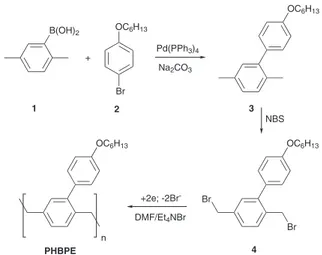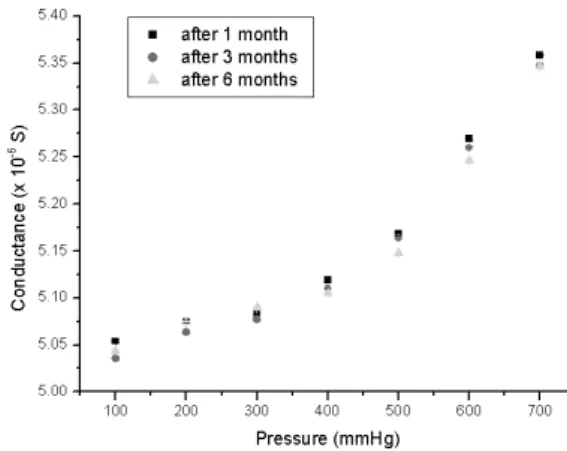Quim. Nova, Vol. 33, No. 10, 2272-2273, 2010
Nota Técnica
*e-mail: jogruber@iq.usp.br
#Dedicated to Prof. Hans Viertler on the occasion of his 70th birth anniversary
MEASURING AIR PRESSURE WITH A POLYMERIC GAS SENSOR#
Juliana R. Cordeiro, Wanderson S. R. Teixeira, Renata Lippi, Rosamaria W. C. Li, Leonardo Ventura e Jonas Gruber* Instituto de Química, Universidade de São Paulo, CP 26077, 05513-970 São Paulo - SP, Brasil
Recebido em 18/6/10; aceito em 12/10/10; publicado na web em 8/11/10
In this communication we describe the application of a conductive polymer gas sensor as an air pressure sensor. The device consists of a thin doped poly(4’-hexyloxy-2,5-biphenylene ethylene) (PHBPE) ilm deposited on an interdigitated metallic electrode. The sensor is cheap, easy to fabricate, lasts for several months, and is suitable for measuring air pressures in the range between 100 and 700 mmHg. Keywords: gas sensor; pressure sensor; conductive polymer.
INTRODUCTION
Most commercially available pressure sensors are mechanical devices, which undergo structural changes caused by the deforma-tion of a sensing element such as diaphragms, capsules, bellows and other components whose shape changes under pressure eventually converting these variations into electrical signals.1
Conductive polymer (CP) based gas sensors are chemoresistive devices easily assembled by the deposition of thin polymeric ilms onto interdigitated electrodes.2 These sensors change their electrical
dc resistance (or ac impedance) upon exposures to a vapor. Both qualitative and quantitative measurements can be performed.2,3
Al-though the response mechanism is still not clear at present, chemical sensing may occur either by swelling of the polymers by the vapor molecules, changing the interchain distances and, hence, the hopping process, or by charge-transfer interactions between the polymers and these vapor molecules.4
In this communication we report a novel application for a CP-based gas sensor. When exposed to dry air at different pressures in the range of 100 to 700 mmHg, its electrical conductance changes proportionally and reversibly. Hence, it can be used as a pressure sensor. As far as we know, this is the irst CP-based pressure sensor ever described.
EXPERIMENTAL
Synthesis
Poly(4’-hexyloxy-2,5-biphenylene ethylene) (PHBPE) (Scheme 1) was prepared as previously reported2 by a palladium-catalyzed
cross-coupling reaction5 of boronic acid 1 with aryl bromide 2,
followed by bromination of the benzylic methyl groups of biphenyl 3 with N-bromosuccinimide (NBS) and controlled potential cathodic reduction6 of 4 leading to PHBPE in 87% yield.
Preparation of the sensor and measurements
A thin (~ 1 µm, determined using a Dektak3 surface proiler) uniform layer of PHBPE doped with 10-canforsulfonic acid (CSA) was deposited onto an interdigitated electrode (Figure 1). The depo-sition was carried out by drop-casting 20 µL of a solution containing 2.5 mg of PHBPE, 0.7 mg of CSA and 0.7 mL of chloroform. CSA
was chosen as dopant because it is a Lewis acid that presents good miscibility with the polymer. The electrode (Figure 1) consists of a lat 23 x 9 mm iberglass substrate with a pair of tin-coated copper interdigitated electrodes (200 µm gaps, 300 µm thickness) obtained from Micropress Ltda. by a silk-screen method usually used in printed circuit fabrication.
The response of the sensor was evaluated by exposing it, in a closed 250 mL vessel (Figure 2), to dry atmospheric air, at 25 oC, at
different pressures between 100 and 700 mmHg. In each experiment, the initial pressure was set at 100 mmHg, then increased stepwise (100 mmHg/step) to 700 mmHg and decreased back to 100 mmHg
Scheme 1. Synthetic route to PHBPE
OC6H13
B(OH)2
+
OC6H13
Br
Pd(PPh3)4
Na2CO3
OC6H13
OC6H13
Br Br
n
NBS
+2e; -2Br
-DMF/Et4NBr
PHBPE
1 2 3
4
Measuring air pressure with a polymeric gas sensor# 2273 Vol. 33, No. 10
be chemical. Probably, the sensor is sensible to one ore more speciic compounds present in the air. The effect of humidity was checked exposing the sensor to air with relative humidity ranging from 30 to ~100%. No change in conductance was observed. This may be due to the hydrophobic nature of the CP.8 Further investigations concerning
the response mechanism of this sensor are beyond the scope of this short technical note and are being performed.
It is worth noting that the cost of a sensor is less than US$ 1.00 and that the conductivity meter and A/D converter cost around US$ 50.00. Finally, several sensors have been tested for over six months and are still responding perfectly well, as shown in Figure 4.
CONCLUSIONS
Gas sensors made from 10-canforsulfonic acid doped poly(4’-hexyloxy-2,5-biphenylene ethylene) ilms deposited onto interdi-gitated electrodes exhibit fast and reversible response towards dry air pressures in the range of 100 and 700 mmHg. Since there is no response when air is substituted by argon, the phenomenon should be a chemical interaction between a speciic compound present in the air and the conductive polymer. The sensors are cheap, easy to fabricate and last for several months.
ACKNOWLEDGEMENTS
The authors would like to thank Conselho Nacional para o Desen-volvimento Cientíico e Tecnológico (CNPq) for its inancial support.
REFERENCES
1. Fraden, J.; Handbook of Modern Sensors, 3rd ed., Springer: New York,
2004.
2. Li, R. W. C.; Ventura, L.; Gruber, J.; Kawano, Y.; Carvalho, L. R. F.;
Sens. Actuators, B2008, 131, 646.
3. Benvenho, A. R. V.; Li, R. W. C.; Gruber, J.; Sens. Actuators, B2009,
136, 173.
4. Slater, J. M.; Watt, E. J.; Freeman, N. J.; May, I. P.; Weir, D. J.; Analyst 1992, 117, 1265.
5. Miyaura, N.; Suzuki, A.; Chem. Rev. 1995, 95, 2457. 6. Utley, J. H. P.; Gruber, J.; J. Mater. Chem.2002, 12, 1613.
7. Rocha, R. T.; Gutz, I. G. R.; Lago, C. L.; J. Chem. Educ.1997, 74, 572. 8. Li, R. W. C.; Carvalho, L. R. F.; Ventura, L.; Gruber, J.; Mater. Sci. Eng.,
C2009, 29, 426. cyclically. The conductance of the sensor was read by a conductivity
meter,7 constructed in our laboratory, converted to a digital signal
that was transferred to a personal computer (PC) in which a software was used to plot graphs of conductance vs. time and conductance vs. pressure.
RESULTS AND DISCUSSION
On exposure to dry air in a system (Figure 2) that allowed ad-justing the internal pressure stepwise from 100 to 700 mmHg, and then back to 100 mmHg. Each test consisted of 17 such cycles. The sensor exhibited electrical conductance values that were proportional to the applied pressure and the observed responses were fast and reversible. The tests were repeated for several months. The graph shown in Figure 3 is a plot of conductance (G) versus pressure (P) and shows that there is a good correlation between them. The error bars represent the total error for each pressure based on data from many sets of 17 cycles each.
In order to verify whether the sensor response is due to chemical interaction between the atmospheric air and the polymer or if it is due to a mechanical response, in which the increasing or decreasing pressure would result in conformational changes in the polymer chains that might cause the conductance to change accordingly, some similar tests were run using dry argon instead of air. No response was observed, which conirms that the nature of the response must
Figure 2. Setup of the equipment used for the measurements
Figure 3. Plot of conductance versus pressure

